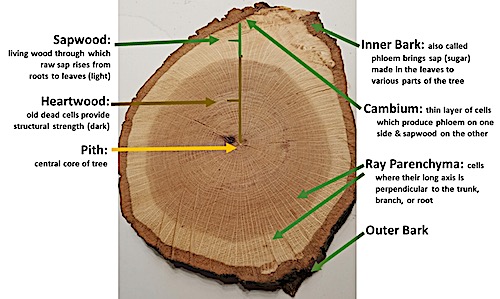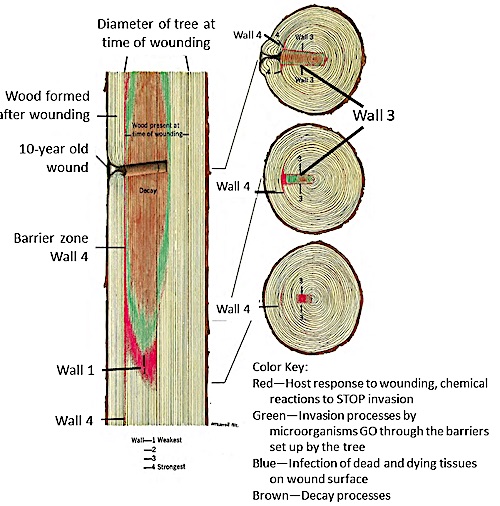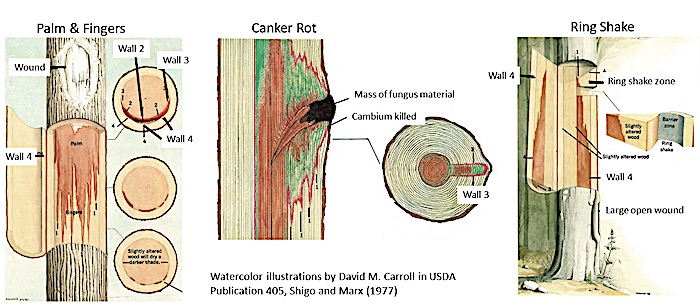CODIT Explained: How Trees Wall Off Damage
By Ann M. Mason, Fairfax Master Gardener Intern
Wind, fire and beetles assault trees and contribute to injury. In my yard, the limbs of oaks and hickories were injured by high winds, and one hangs limply about 50 feet up. (It is in the woods and not in a position to hit a house or any person. The arborist was not worried and suggested we do nothing.) Sadly, if we prune trees incorrectly, we can cause injury that can lead to tree decline. Within the gardening community, we say “People heal — trees seal.” Well, how do trees seal?
This article explores the science behind how trees seal, more accurately, wall off damage. Called Compartmentalization of Damage in Trees (CODIT), it is a fundamental process that we gardeners need to know a bit about.

Tree Structure (cross section)
As gardeners, we often like to show and let children count the growth rings formed from the spring (light) and autumn (darker) bands of growth. If we look closely, we see that the cambium forms cells that are longitudinal (parallel) to the axis of the trunk, branch or root, and cells that are perpendicular to that axis. The perpendicular cells become parenchymal rays that partition the wood; the longitudinal cells fill the compartments between the rays.
With this background, we are ready to discuss how trees wall off wounding injury and the assault of invading microorganisms. In 1935, pathologist Dr. George H. Hepting reported that trees appeared to limit fungi and bacterial invasions after injury. After 16 plus years of research and dissection of thousands of trees around the world, Dr. Alex L. Shigo, along with colleagues Dr. Walter Shortle and others at the US Department of Agriculture, Forest Service, wrote extensively on the CODIT model. Their research found trees are highly compartmentalized and use their structure to respond to, i.e., wall off, injury.

Illustrating CODIT Walls (longitudinal and cross section)
Thus, CODIT describes the process trees use to form walls around wounding injury and the related assault of microorganisms, both fungi and bacteria, that threaten to destroy tree health.

Tree Injuries that Do Not Follow the CODIT Model
While tree injury from birds, beetles, fire and wind is beyond the gardeners’ action, proper pruning techniques can limit tree injury from gardeners. Pruning just outside of the branch collar and at a 45- to 60-degree angle to the branch bark ridge allows the tree’s walling mechanisms to work. Pruning that cuts into the branch collar, into the branch bark ridge, or leaves a branch stub leaves an open invitation to invading microorganisms. Pruning techniques are covered in Virginia Cooperative Extension Publication 430-455 and in another Fairfax Gardening article, “Why Do We Prune Deciduous Shrubs and Trees?”
Resources
• Compartmentalization of Decay in Trees, Alex L Shigo, Scientific American (1985)
• Compartmentalization of Decay in Trees, Alex L. Shigo and Harold G. Marx, US Department of
Agriculture, Bulletin No. 405, (1977)
• Ability to compartmentalize decay differs among trees, University of Florida
• Wood Decay in Living and Dead Trees: A Pictorial Overview, Walter C. Shortle, Kenneth R. Dudzik, US
Department of Agriculture, General Technical Report NRS-97 (2011)
• Why Do We Prune Deciduous Shrubs and Trees?, Fairfax Gardening, Gil Medeiros
• A Guide to Successful Pruning: Pruning Basics and Tools, Susan C. French and Bonnie Lee Appleton,
Virginia Cooperative Extension, Publication 430-455 (2009)
• Patterns of storm injury and tree response, K.T Smith, W.C. Shortle and K.R. Dudzik, U.S. Department of
Agriculture, Forest Service, Northeastern Area, State and Private Forestry (2001) Bulletin NA-TP-02-01